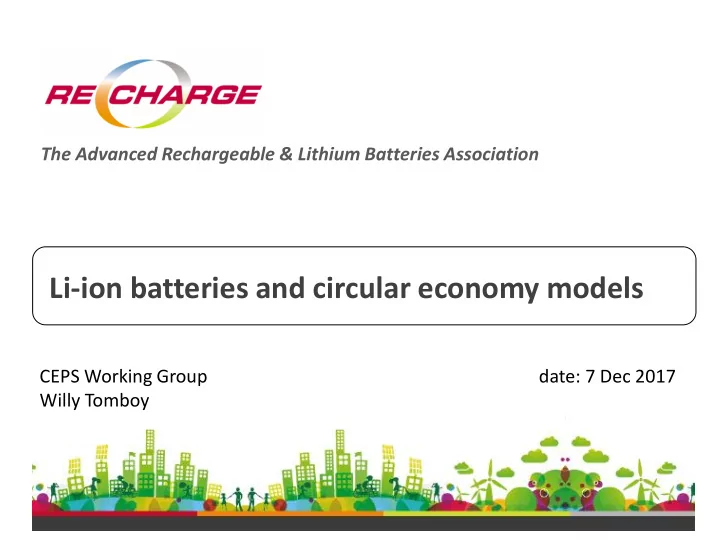

The Advanced Rechargeable & Lithium Batteries Association Li-ion batteries and circular economy models CEPS Working Group date: 7 Dec 2017 Willy Tomboy
RECHARGE – who we are The Advanced Rechargeable & Lithium Batteries Association 2
EU’s Circular Economy approach...and batteries Circular Economy keeps the added value in products for as long as possible and eliminates waste. The objective is also to keep resources within the economy when a product has reached the end of its service life, so that they can be productively used again and again and hence create further value. Member States shall take measures to promote re-use activities and the extension of the life span of products (provided the quality and safety of products are not compromised) by encouraging the establishment and support of recognized re-use networks and by incentivizing remanufacturing, refurbishment and repurposing of products. The Advanced Rechargeable & Lithium Batteries Association 3
A zero-waste program for Europe It is obvious that the priorities of the legislator evolve into the direction of: 1. Extension of the product’s service life 2. Use of recycled materials 3. Re-use and second life (the end of use is not the end of life) The EU Commission acknowledges that the re-use of batteries is a possible new market, and that the lack of definition for the re-use and of second life has to be addressed in a potential future revision of the Batteries Directive 2006/66/EC. The Advanced Rechargeable & Lithium Batteries Association 4
1. Extending the life cycle of batteries: a significant reduction of environmental impacts* A battery is as green as the energy it is using • The battery footprint profile is very similar to the electricity profile. • Increasing the life duration is increasing the energy usage. • But thanks to a longer usage of the battery material, all the environmental impacts are reduced! *based on the results from the Product Environmental Footprint (PEF) project on batteries The Advanced Rechargeable & Lithium Batteries Association 5
2. Recycling from the different types of batteries Portable battery – any battery, button cell, battery pack that is sealed, can be hand-carried, is neither an industrial nor an automotive battery • Collection target based on PoM (45% since 9/2016) • Problem for portable rechargeable longer lifetime than primary batteries (+ hoarding effect) should be based on available/regenerated for collection • Should be aligned with WEEE requirements • Need to have seperate ‘portable rechargeable batteries’ collection target • Level of recycling: ratio between what has been colllected and what has been recycled high level The Advanced Rechargeable & Lithium Batteries Association 6
2. Recycling from the different types of batteries Portable battery – any battery, button cell, battery pack that is sealed, can be hand-carried, is neither an industrial nor an automotive battery • Collection target based on PoM (45% since 9/2016) • Problem for portable collection no harmonized reporting, and large differences between memberstates. • Problem with the batteries contained in WEEE: the two options should be clarified: • either the separation of the batteries from the WEEE flows, • or the recycling with WEEE but with reporting according to the Batteries Directive. The Advanced Rechargeable & Lithium Batteries Association 7
2. Recycling from the different types of batteries Automotive battery – any battery used for automotive starter, lighting or ignition power (SLI) • Collection schemes to be set up by producer – no specific target • High level of collection due to Pb pricing Industrial battery – any battery designed for exclusively industrial or professional uses or used in any type of electric vehicle • Take-back obligation by producer • Landfill ( is a waste of waste ) & incineration forbidden high take-back level The Advanced Rechargeable & Lithium Batteries Association 8
2. Recycling Efficiency • Target values defined for recycling efficiency for each chemistry were based on feasibility, and requires the recovery of almost 100% of the heavy metal: – 75% in weight for Ni-Cd – 65% in weight for Lead acid • Target for “other batteries” – 50% in weight for others batteries. • The risk of dispersion of Hg,Pb and Cd in the environment is controlled through: – Prohibiting Hg and Cd in specific subsets of batteries (see art 4) for which 100% collection cannot be guaranteed – Specifying: “including recycling of the lead/cadmium content to the highest degree that is technically feasible while avoiding excessive costs” in the RE Annex III 9 The Advanced Rechargeable & Lithium Batteries Association
3. Re-use and Second life • Clarifying the definitions of re-use (same application) and second life (different application) would benefit both regulators and industry for what concerns the extended producer responsibilities (EPR), especially in the area of industrial batteries for the traction of e-mobility vehicles (hybrid, plug-in hybrid, full electric, fuel cell). • Why is that ? • Batteries are very high-tech components • In development for better energy density and extended driving range • Are of an extremely high design quality (quality control at manufacturing & assembly is very tight) • Are about the most expensive component in the e-mobility vehicle Energy Storage Systems represent one of the potential applications as second life. The Advanced Rechargeable & Lithium Batteries Association 10
Thanks for your kind attention The Advanced Rechargeable & Lithium Batteries Association www.rechargebatteries.org Avenue de Tervueren, 168 - Box 3 B - 1150 Brussels, Belgium Tel. +32 2 777 05 67 Fax +32 2 777 05 65 The Advanced Rechargeable & Lithium Batteries Association 11
Recommend
More recommend